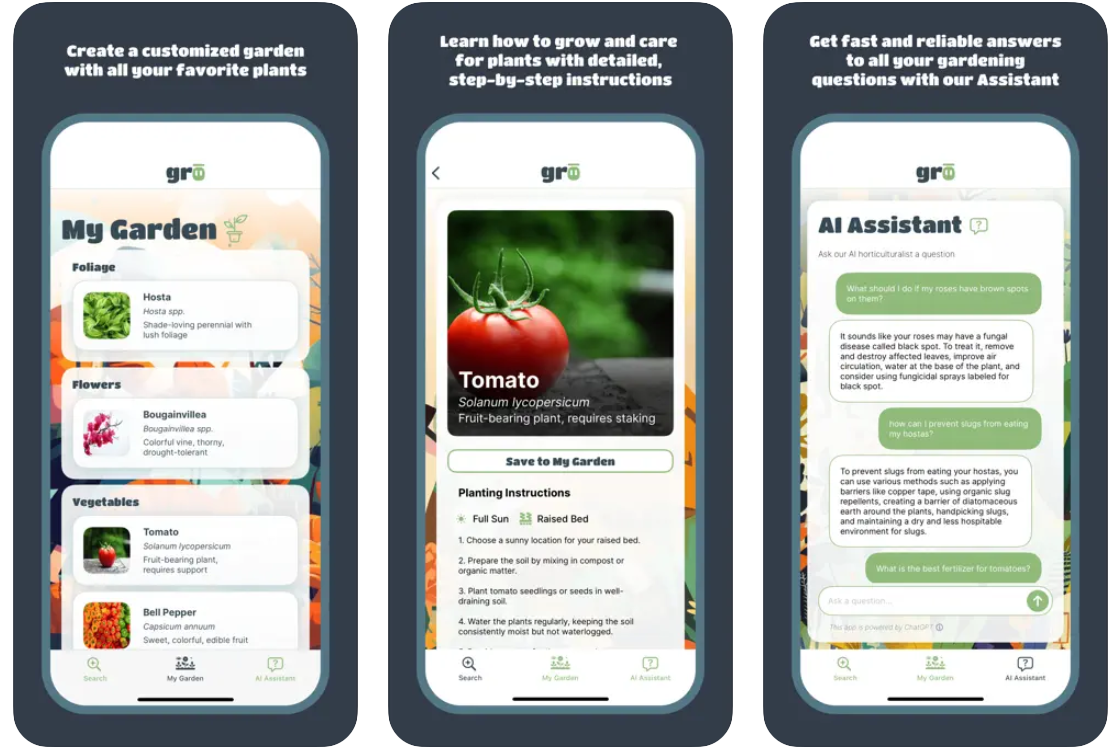GRŌ Your Offerings with AI Integrations

In June 2024, Grio launched the GRŌ app: an AI gardening assistant for novice gardeners. The GRŌ app was an excellent way for us to understand the full extent of AI’s capabilities while identifying pitfalls and limitations to avoid on future projects.
Challenges and Limitations of AI Integration
As we began developing the GRŌ app, we ran into some initial challenges associated with the AI integrations:
Choosing the Source AI
When we initially began planning GRŌ, we considered several of the top open-source AIs, including Gemini (formerly Bard) and ChatGPT. We quickly discovered that one of the biggest hurdles to AI integration is also one of the first you face: the AI waitlist. As new open-source AIs are released, they are only offered to a limited number of users.
This presents an interesting conundrum for new apps. You can either delay your app release as you wait for access to the newest version of an AI or you can use an older, open version. If you use an older version, your AI may not be as accurate, but you may make it to market faster.
For GRŌ, we discovered a good compromise between the two options. We began with GPT-3.5, as we were immediately granted access. Once we were able to use GPT-4, we upgraded to use the newer version of the system. While this may have added some time to the project, starting with 3.5 allowed us to get a good sense of how to use the system.
Crafting Effective Queries
The GRŌ app uses two AI integrations. In the first, users enter information about their location and the AI produces specialized recommendations for plants and care based on their biome and their USDA Hardiness Zone.
The challenge with this integration was not getting the AI to return information, it was getting the AI to return the right information in the right format. Our developers spent time experimenting with how to set up the query within the code to ensure that users received relevant, concise responses each time.
Financial Burden of Chat Feature
The second AI integration we used in the GRŌ app was for the user’s personal AI gardening assistant. With the assistant, users are able to type in questions and receive immediate responses.
This integration allows us to provide a level of service that is not available in other gardening apps on the market. However, this feature also creates an added financial burden, as we must pay for every question that users ask.
To reduce the financial burden without compromising the experience, our developers implemented two key solutions. First, they created parameters for how the gardening assistant would answer questions. For example, the geographic data collected in the first integration is submitted along with the user’s query, allowing the AI to provide personalized responses that align with the user’s climate.
Second, our developers created parameters for which questions the gardening assistant would answer. To prevent the assistant from being used for all AI questions the user may have throughout their day, our developers specified that the gardening assistant could only answer gardening and plant-related questions. If the user asks something outside of this scope, the AI assistant responds with: “I am an AI Horticulturist. I can only answer questions about plants and gardening.”
Limitations of the Dataset
The biggest limitation of this AI integration was that we were dependent on ChatGPT’s knowledge base. For a gardening app, this isn’t a prohibitive issue, as ChatGPT’s dataset includes countless gardening and horticulture sources. However, for a company creating a very technical or domain-specific app, a general dataset would not be sufficient.
If you want a highly accurate AI, then you need to create a specialized dataset that it can learn from. This is cost-prohibitive for most organizations, making it difficult to create a fully accurate AI integration.
For the GRŌ app, we provide up-front language that explains that the app uses ChatGPT integrations and that AI does not always provide accurate results. We also allow users to re-ask questions if they feel that they have not received a sufficient answer in the AI’s initial response.
Benefits of AI Integration
The GRŌ app highlighted two large benefits of AI integration:
Offering Personalized App Experiences
When users begin their GRŌ journey, they provide information about their garden location. With AI integration, we were able to instantly collect this information and return personalized plant and care recommendations based on their biome.
AI has allowed developers to create much more personalized experiences for users, thereby improving the overall user experience.
Offering Chat Assistance 24×7
With the GRŌ AI gardening assistant, users have immediate answers to their questions 24/7. Where before, companies were limited by the number of people they could hire, it is now easy to provide round-the-clock service for a fraction of the cost. This level of availability improves user experience and customer loyalty.
Improve Your App with AI Integrations Today
AI integrations are revolutionizing the ways we create and utilize apps. At Grio, we are finding innovative ways to use AI integrations and maximize your app’s potential. Set up a free consultation today and find out how our AI experts can help you create an exceptional app.
